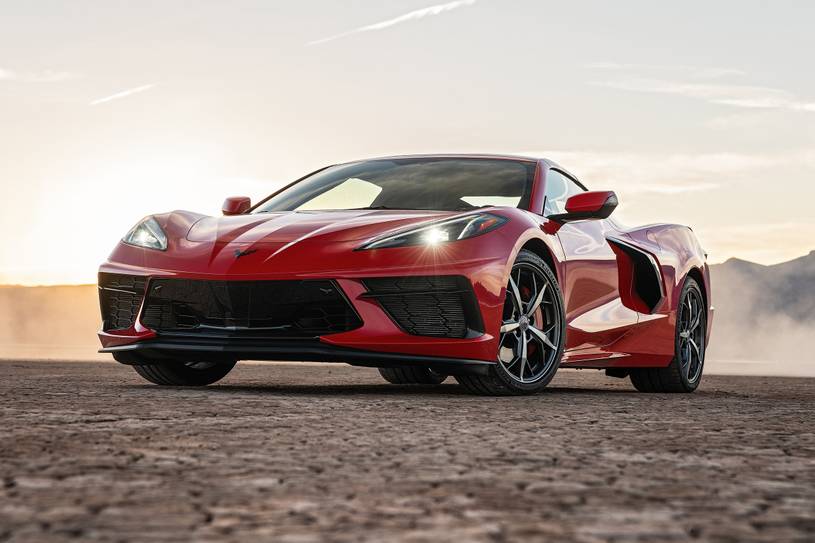What is it?
A new generation of the longest-running name in American sports cars is a big deal. But the 2020 Chevrolet Corvette Stingray goes further by making the most significant fundamental change for the brand in its history: moving the engine to the middle while somehow keeping the base price around $60,000.
Chevy says it reached the performance limits of the front-engine/rear-drive layout the Corvette has used since the '50s. Sandwiching the engine between the passenger compartment and the rear axle comes with myriad performance benefits. It also radically freed up Corvette design for the all-new model.
But don't fret, traditionalists. The mid-engine Corvette's 6.2-liter V8 may sit under glass in the back, but it makes 495 horsepower (40 hp more than the base spec of the current C7 Corvette) and 470 lb-ft of torque when equipped with the optional exhaust upgrade. It also retains a pushrod design, which sacrifices valvetrain sophistication for compactness and simplicity, and rear-wheel drive remains the only available layout. Or maybe start fretting, since the initial transmission offering is an eight-speed dual-clutch automatic. And there's no indication we should expect a manual transmission in the future.
The eighth-generation mid-engine Corvette also eschews the old transverse leaf-spring suspension for a more sports-car-conventional coil-over damper setup. Its significantly higher cornering ability meant Chevy had to retool the C8's lubrication system. Now, even the base Corvette has dry-sump oiling, which ensures constant engine lubrication when approaching (or exceeding) 1.0g of lateral acceleration.
The mid-engine setup brings other significant changes. The passenger compartment now sits forward 16.5 inches — significantly closer to the front wheels — which provides a better sense of control. Moving the engine out of the way also permits a shorter and, Chevy says, more direct steering system. The hood now sits lower, too, enabling a larger windshield and better forward visibility.
The steering wheel is unusual in that it has a squared-off top and bottom. Though the design looks peculiar, in our experience it has benefited the driving experience in exotic cars such as the Aston Martin Vanquish and the Ferrari LaFerrari.
Behind the wheel is a 12-inch customizable gauge cluster. To its right sits a large infotainment display that hosts Chevy's latest entertainment software. Interior materials include hand-wrapped leather, real metals and carbon fiber. Beyond an array of color and stitching options, you now have three seat options, ranging from comfort-oriented to heavily bolstered performance buckets. We have some questions about how easy this interior will be to live with in the real world, especially the column of HVAC controls stuck off on the passenger side of the transmission tunnel. In terms of controls, the old C7 was pleasantly straightforward.
You'll also have to learn to find the door, hood and hatch releases, which are hidden to avoid upsetting the design. But after familiarization, getting in and out should be easier than with other such sports cars since Chevy stressed the importance of narrow doorsills while designing the Corvette's structure. The roof is still removable too.
Like the removable roof, other popular Corvette features remain. The performance-enhancing optional Z51 package includes larger brake rotors with upgraded front brake cooling, upgraded drivetrain cooling, its own final drive ratio, and a performance exhaust. It also has a clever electronically controlled limited-slip differential to manage torque distribution between the rear wheels. An upgraded version of Magnetic Ride Control is optional, as is Chevy's stellar Performance Traction Management system.
The biggest loss for a certain kind of Corvette traditionalist is cargo volume. The large rear hatch space made the last few generations of Corvette a practical car for a weekend getaway or golf trip. This new Corvette splits the space into two smaller trunks — one front and one rear — that offer a combined 12.6 cubic feet of space. Chevy says the front compartment can fit a carry-on-size bag and a laptop bag. The total storage is a far cry from the last-generation Corvette, whose 15 cubic feet under its hatchback made it the world's most practical sports car.
While Chevy claims that the new Vette can still accommodate two golf bags, we'll file real-world cargo capacity under "Wait and See." But at least owners won't have to worry about scraping the nose on their driveways. A front suspension lift raises the nose by 1.5 inches and can be programmed to work automatically based on GPS location.
Throw in that remarkably low starting price of around $60,000, and Chevy seems to have made what amounts to an everyman's supercar.










